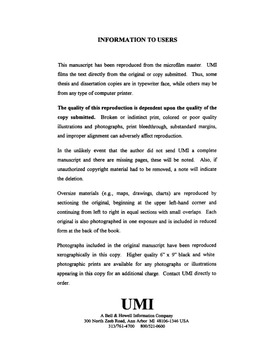| dc.contributor.advisor | Harris, Betty J., | en_US |
| dc.contributor.author | Moretti-langholtz, Danielle. | en_US |
| dc.date.accessioned | 2013-08-16T12:30:06Z | |
| dc.date.available | 2013-08-16T12:30:06Z | |
| dc.date.issued | 1998 | en_US |
| dc.identifier.uri | https://hdl.handle.net/11244/5664 | |
| dc.description.abstract | Historically, Virginia's indigenous Indian tribes have been subsumed under non-Indian racial categories. Typically, Virginia Indians were classified as "free persons of color, " somewhat in midpoint on the bi-racial continuum. During the eighteenth and nineteenth centuries, the Commonwealth of Virginia redefined its racial categories and enacted legislation which forced persons into an even more rigid black/white racial dichotomy, making it increasingly difficult for individuals to identify themselves as Virginia Indians. With the passage of the Racial Integrity Act in 1924, Virginia Indians were prohibited by law from identifying themselves as "Indians." The Racial Integrity Act, sponsored by activist members of the Eugenics Movement, remained in effect until a United States Supreme Court ruling in 1968 declared it unconstitutional. | en_US |
| dc.description.abstract | This dissertation explores the political and racial landscape of Virginia between the seventeenth century and the twentieth century, as it pertains to Virginia's Indian population. The papers of Walter Plecker, head of the Bureau of Vital Statistics during the period of the enforcement of the Racial Integrity Act, are discussed, revealing the links between Plecker and the Eugenics Movement. In 1983 the Commonwealth of Virginia granted state recognition to six Indian tribes, thus beginning the public process of reconstructing an Indian identity and the re-establishing of political power for Virginia's tribes and persons of Indian descent living within the Commonwealth. Two additional tribes have received state recognition in 1985 and 1987, thereby strengthening the Indian presence in Virginia. This dissertation places special emphasis on the workings of the Virginia Council on Indians, an advisory board established in 1983. The Council functions as a supra-tribal organization that takes an active role in shaping the political agenda of the state-recognized tribes vis a vis the state and local government. The challenge to Virginia Indians at the close of the twentieth century is to overcome the lack of understanding about their history and culture, and to highlight their contemporary struggle for federal recognition. Questions pertaining to the construction of Indian identity and the relationship between sanctioned versions of American colonial history and Virginia Indian history are examined. | en_US |
| dc.format.extent | ix, 339 leaves ; | en_US |
| dc.subject | Sociology, Ethnic and Racial Studies. | en_US |
| dc.subject | Indians of North America Virginia. | en_US |
| dc.subject | Indians of North America History 20th Century. | en_US |
| dc.subject | Indians of North America Virginia Ethnic identity. | en_US |
| dc.subject | History, United States. | en_US |
| dc.subject | Anthropology, Cultural. | en_US |
| dc.title | Other names I have been called: Political resurgence among Virginia Indians in the twentieth century. | en_US |
| dc.type | Thesis | en_US |
| dc.thesis.degree | Ph.D. | en_US |
| dc.thesis.degreeDiscipline | Department of Anthropology | en_US |
| dc.note | Adviser: Betty J. Harris. | en_US |
| dc.note | Source: Dissertation Abstracts International, Volume: 59-07, Section: A, page: 2584. | en_US |
| ou.identifier | (UMI)AAI9839798 | en_US |
| ou.group | College of Arts and Sciences::Department of Anthropology | |
